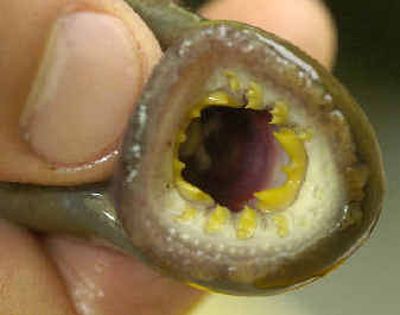Federal protected status for lampreys rejected

GRANTS PASS, Ore. – A petition from environmentalists to put four species of lamprey – jawless fish resembling eels that swim with salmon – under protection of the Endangered Species Act has been rejected again by the U.S. Fish and Wildlife Service.
Dave Allen, Northwest regional director of the agency, said the petition from 11 environmental groups did not contain enough information to consider undertaking a full-scale review of whether Pacific lamprey and three others species warrant listing as threatened or endangered species.
Allen acknowledged that declines in some lamprey populations have been documented, but they were not detailed enough for the agency to study the declines further.
He urged continuing efforts to build knowledge about lamprey, such as a summit held this year by the Columbia River Inter-Tribal Fish Commission. Lamprey are a traditional food harvested by Northwest tribes, which are involved in restoration efforts.
The decision outraged environmentalists, who noted that all 31 species placed under protection of the Endangered Specifies Act by Fish and Wildlife since the Bush administration took office have been the subject of federal court orders.
“We are not giving up on the lamprey,” said Noah Greenwald, conservation biologist for the Center for Biological Diversity, one of the petitioners. “We are either going to file suit to overturn this negative 90-day finding or submit more information to the Fish and Wildlife Service.”
He added that a federal judge in Colorado recently ordered the service to do further study on Yellowstone cutthroat trout after the agency declined to take up that petition.
Environmentalists petitioned for protect Pacific lamprey, river lamprey, Kern brook lamprey and Western brook lamprey in January 2003.
Fish and Wildlife initially responded they saw no reason to grant emergency protection for any of the species, and would not have the time or money to begin formal consideration until a new budget year. As they have with many species, including the Northern spotted owl, environmentalists then sued to force consideration and last month Fish and Wildlife agreed to take the first step toward consideration of a listing, known as a 90-day review. Full consideration would take a year.
Pacific lamprey and river lamprey inhabit medium and large streams from Mexico to Alaska. Western brook lamprey inhabit small tributaries from the Sacramento River to British Columbia. Kern brook lamprey are found in California’s San Joaquin River Basin.
Listing any of them as a threatened or endangered species could complicate battles in the West over the impact on salmon from logging, hydroelectric dams and irrigation for farms.
Like salmon, lamprey grow up in fresh water, go to the ocean to mature, and return to rivers to spawn.
“This is a case of a political decision trumping the knowledge at hand,” said Charles Hudson, spokesman for the Columbia River Inter-Tribal Fish Commission, which supports lamprey restoration efforts but was not one of the petitioners.
At the commission’s lamprey summit, “It was generally agreed we don’t know a whole lot about this species, but it’s very evident lamprey are not in the abundance or the areas they were historically,” Hudson said.
“It’s generally believed that the hydropower system has been the biggest source of mortality. Estimates are that every project wipes out about half the migrating population, which is considerably more impact than on salmon.”